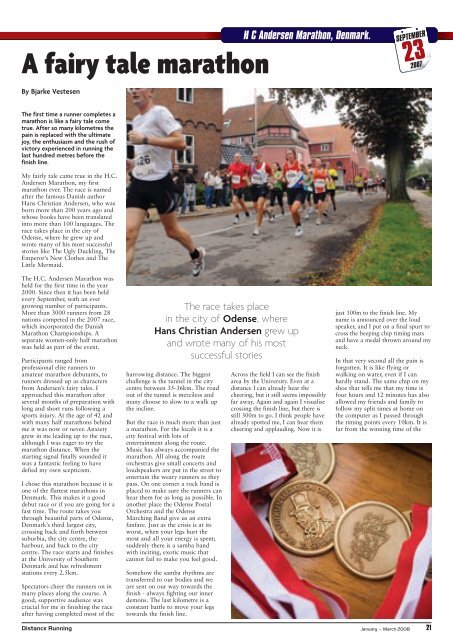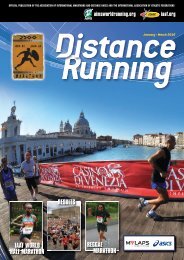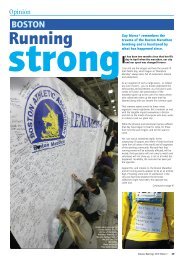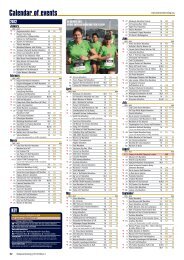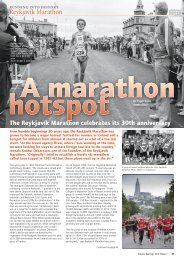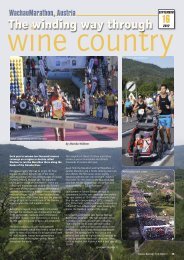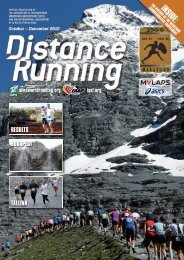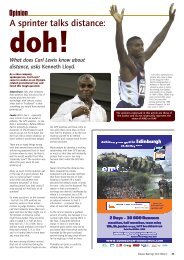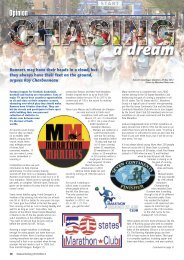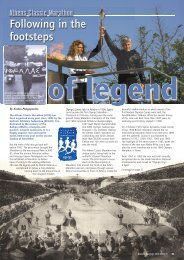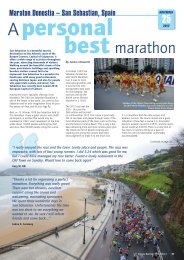Download pdf - Distance Running magazine
Download pdf - Distance Running magazine
Download pdf - Distance Running magazine
You also want an ePaper? Increase the reach of your titles
YUMPU automatically turns print PDFs into web optimized ePapers that Google loves.
A fairy tale marathon<br />
H C Andersen Marathon, Denmark.<br />
SEPTEMBER<br />
23<br />
2007<br />
By Bjarke Vestesen<br />
The first time a runner completes a<br />
marathon is like a fairy tale come<br />
true. After so many kilometres the<br />
pain is replaced with the ultimate<br />
joy, the enthusiasm and the rush of<br />
victory experienced in running the<br />
last hundred metres before the<br />
finish line.<br />
My fairly tale came true in the H.C.<br />
Andersen Marathon, my first<br />
marathon ever. The race is named<br />
after the famous Danish author<br />
Hans Christian Andersen, who was<br />
born more than 200 years ago and<br />
whose books have been translated<br />
into more than 100 languages. The<br />
race takes place in the city of<br />
Odense, where he grew up and<br />
wrote many of his most successful<br />
stories like The Ugly Duckling, The<br />
Emperor’s New Clothes and The<br />
Little Mermaid.<br />
The H.C. Andersen Marathon was<br />
held for the first time in the year<br />
2000. Since then it has been held<br />
every September, with an ever<br />
growing number of participants.<br />
More than 3000 runners from 28<br />
nations competed in the 2007 race,<br />
which incorporated the Danish<br />
Marathon Championships. A<br />
separate women-only half marathon<br />
was held as part of the event.<br />
Participants ranged from<br />
professional elite runners to<br />
amateur marathon debutants, to<br />
runners dressed up as characters<br />
from Andersen’s fairy tales. I<br />
approached this marathon after<br />
several months of preparation with<br />
long and short runs following a<br />
sports injury. At the age of 42 and<br />
with many half marathons behind<br />
me it was now or never. Anxiety<br />
grew in me leading up to the race,<br />
although I was eager to try the<br />
marathon distance. When the<br />
starting signal finally sounded it<br />
was a fantastic feeling to have<br />
defied my own scepticism.<br />
I chose this marathon because it is<br />
one of the flattest marathons in<br />
Denmark. This makes it a good<br />
debut race or if you are going for a<br />
fast time. The route takes you<br />
through beautiful parts of Odense,<br />
Denmark’s third largest city,<br />
crossing back and forth between<br />
suburbia, the city centre, the<br />
harbour, and back to the city<br />
centre. The race starts and finishes<br />
at the University of Southern<br />
Denmark and has refreshment<br />
stations every 2.5km.<br />
Spectators cheer the runners on in<br />
many places along the course. A<br />
good, supportive audience was<br />
crucial for me in finishing the race<br />
after having completed most of the<br />
The race takes place<br />
in the city of Odense, where<br />
Hans Christian Andersen grew up<br />
and wrote many of his most<br />
successful stories<br />
harrowing distance. The biggest<br />
challenge is the tunnel in the city<br />
centre between 35-36km. The road<br />
out of the tunnel is merciless and<br />
many choose to slow to a walk up<br />
the incline.<br />
But the race is much more than just<br />
a marathon. For the locals it is a<br />
city festival with lots of<br />
entertainment along the route.<br />
Music has always accompanied the<br />
marathon. All along the route<br />
orchestras give small concerts and<br />
loudspeakers are put in the street to<br />
entertain the weary runners as they<br />
pass. On one corner a rock band is<br />
placed to make sure the runners can<br />
hear them for as long as possible. In<br />
another place the Odense Postal<br />
Orchestra and the Odense<br />
Marching Band give us an extra<br />
fanfare. Just as the crisis is at its<br />
worst, when your legs hurt the<br />
most and all your energy is spent;<br />
suddenly there is a samba band<br />
with inciting, exotic music that<br />
cannot fail to make you feel good.<br />
Somehow the samba rhythms are<br />
transferred to our bodies and we<br />
are sent on our way towards the<br />
finish - always fighting our inner<br />
demons. The last kilometre is a<br />
constant battle to move your legs<br />
towards the finish line.<br />
Across the field I can see the finish<br />
area by the University. Even at a<br />
distance I can already hear the<br />
cheering, but it still seems impossibly<br />
far away. Again and again I visualise<br />
crossing the finish line, but there is<br />
still 300m to go. I think people have<br />
already spotted me, I can hear them<br />
cheering and applauding. Now it is<br />
just 100m to the finish line. My<br />
name is announced over the loud<br />
speaker, and I put on a final spurt to<br />
cross the beeping chip timing mats<br />
and have a medal thrown around my<br />
neck.<br />
In that very second all the pain is<br />
forgotten. It is like flying or<br />
walking on water, even if I can<br />
hardly stand. The same chip on my<br />
shoe that tells me that my time is<br />
four hours and 12 minutes has also<br />
allowed my friends and family to<br />
follow my split times at home on<br />
the computer as I passed through<br />
the timing points every 10km. It is<br />
far from the winning time of the<br />
<strong>Distance</strong> <strong>Running</strong> January – March 2008<br />
21


